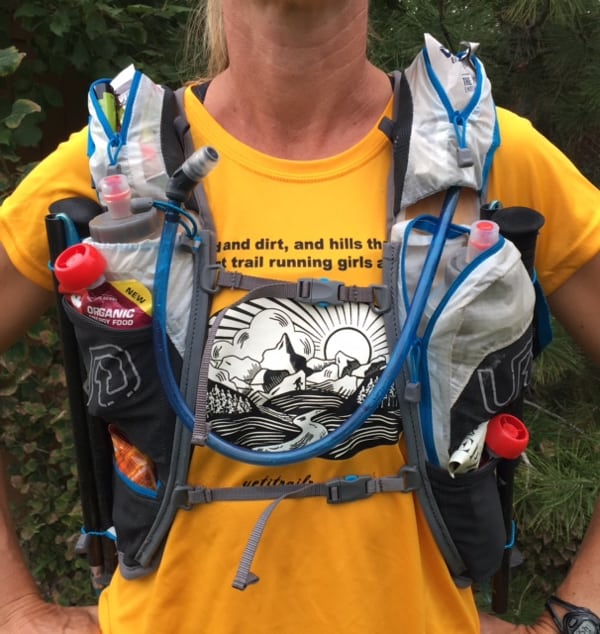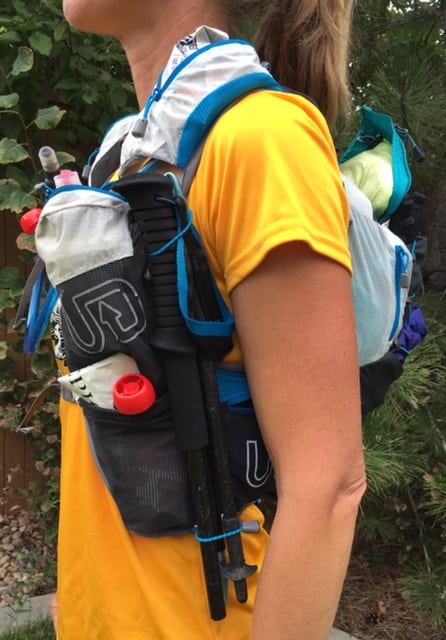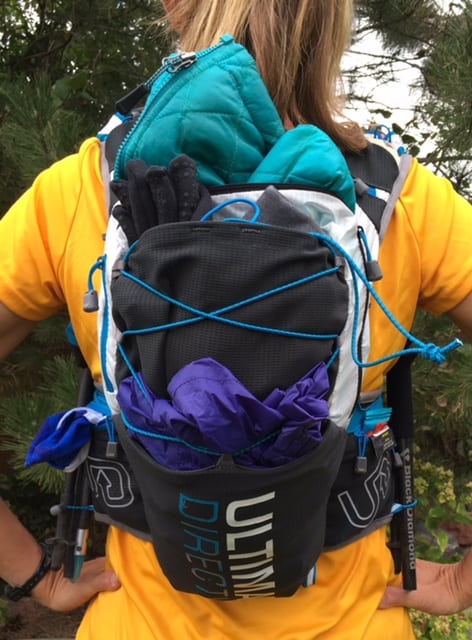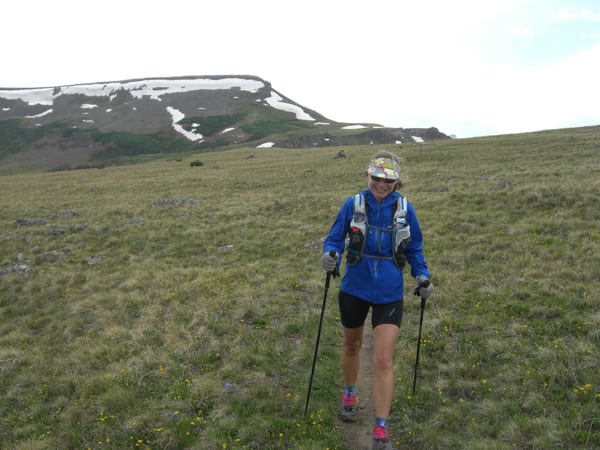What do you do if your next series of adventures requires somewhat of a ‘pack it all and the kitchen sink, too’ approach to gear selection? What if you only want one pack for all runs over a few hours but may also include times when stashing a puffy, some Kahtoola Microspikes, and an ice axe will be desired? Ultimate Direction has made some serious improvements to the Peter Bakwin Adventure Vest this year, and the 3.0 is an incredible pack that demands attention. The Ultimate Direction PB Adventure Vest 3.0 ($170) now boasts 16 liters (977 cubic inches) of storage capacity, which is an increase of five liters from the 2.0 version, yet the pack has decreased in weight by three ounces to 13.2 ounces. I’ve been doing my best to put this pack through some burly tests, and thus far, it’s passing them all with flying colors.
Sizing
The 3.0 vest fits differently than previous versions. Ultimate Direction has included a new sizing chart and measurement map that requires a measurement of the bottom ribs. The pack comes in unisex (I’d call it more of a men’s fit than a women’s) small, medium, and large, which currently covers lower-rib-cage measurements from 24 to 46 inches. It’s interesting to note that with the 2.0 pack, they added an extra-large size awhile after the initial release, perhaps in response to customer feedback. I’m curious if that will happen with the 3.0 or if the new size ranges are adequately inclusive.
I wear a 34A sports bra and measure 29 inches around the bottom of my ribs. This put me firmly in the small size, which fits perfectly. Incidentally, I had the opportunity to try a medium out in a store to compare, and though I liked the increased size of the side pockets of the medium, I was unable to cinch it down sufficiently to hold the load stable. With the adjustability of the hidden side straps and the front straps, significant customization is possible even if you’re between sizes.

Front view of the Ultimate Direction PB Adventure Vest 3.0. All photos: iRunFar/Kristin Zosel unless otherwise noted
Fit/Comfort
I tested the fit and comfort of this pack out in the most direct way possible. I received the pack on a Wednesday. I loaded my pack up with random mountain gear and did a two-hour test run/hike on Thursday on my favorite Guanella Pass area trail. It passed with flying colors. On Saturday, it was fully loaded with gear for a high-mountain 50 miler with nine slow mountain miles between some aid stations and at least a third of the race around 13,000 feet. Who says you shouldn’t try new things on race day? I had nary a chafe mark and only a small sore spot on one rib where the rim of a bottle in the burrito pocket was pressed after it was empty and deflated with a full bottle on top—rookie error. The pack allows the weight of the load sit right in the sweet spot (for me) of slightly lower on my back and correctly balanced front to back whether it’s completely full or on the lighter side.
I have further used the pack for pacing many hours at Hardrock, several long days in the mountains, and for a night adventure on a 14,000-foot peak complete with scrambling and off-trail time. I definitely ‘packed for my fears’ on that one and maxed out the 16-liter volume and weight-carrying capacity of the pack. Yet again, I had no chafing and a small sore spot on one rib where, amazingly, I did the same thing with a soft water bottle as in my 50-mile race. I’m slow to learn. In all these miles, I’ve worn the pack over several combinations of the following: a thin synthetic shirt, one or two wool layers, a lightweight windbreaker jacket, a waterproof jacket, and a thin puffy. There’s no bounce and no difficulty in adjusting the front straps to alter the fit on the fly as needed.
I can in all honestly say I love this pack. It has completely replaced my 12-liter pack and an older larger-capacity pack I’ve had for years from other brands. I’m psyched to conjure another adventure where I get to use the pack because I know I can fill it, set it, and forget it, which allows me to focus on the journey itself.

Side view of Ultimate Direction PB Adventure Vest 3.0.
Design/Construction
It’s clear that a significant amount of design, testing, and adventure experience went in to the PB Adventure Vest 3.0. The entire pack is edged in a thick but non-rigid, very-soft-fleece material—the most comfortable edging of any pack I’ve tried. It helps with moisture management around the neck and underarms but interacts completely peacefully with any exposed skin while not creating friction against any wool or synthetic shirt or jacket.
The 150-grams-per-square-meter (GSM) Knit Mono Mesh makes up most of the pack that comes in contact with your body with the exception of two stretch panels on the sides. This translucent fabric is relatively smooth and has small uniform perforations that enhance air flow and moisture management while riding smoothly against the skin or clothing. It provides a conforming feel as you cinch the pack and amazingly does not eat your shirt (cause it to rise up under the pack into a clump about mid-ribs) as you run up and down mountains or pound over a jeep road.
The aforementioned side panels utilize 180 GSM Darlington Power Mesh, which has larger micron holes and a stretchier feel. My rib cage loves the expansion ability this allows as I power up the steep inclines and less-than-gracefully descend without needing to adjust any straps. This Power Mesh is also used to form the stretchy pockets on the outside of the pack in the front, sides, and the back. This allows extra food, fluids, and gear to be stored securely without having gaping pockets when they’re not in use.
Anecdotally, I’m wondering if this pack doesn’t get better with age. I’ve watched the video of Peter Bakwin and his pack several times on the Ultimate Direction website, and I’m always impressed with the stretchiness of the external pockets on his pack and the amount of stuff he fits in with ease. While my ‘still-newish’ pack holds plenty, I think the Power Mesh will continue to accommodate to varying loads and may expand over time as the elasticity gives a bit, but it doesn’t seem that it will ever give so much as to become sloppy. I think this will be a bonus… except for the fact that increasing the weight in my pack beyond its current state is perhaps not the best idea for my body.
The zippers and bungees all have pull tabs that are very easy to adjust with bare and running-gloved hands. The smooth-pulling zipper angles are also such that no contortions are needed for the front and side pockets. The pockets in the rear require me to take off the pack.
The rest of the main body of the pack utilizes SilNylon/66, a silicone-impregnated 30-denier nylon with a polyurethane face. It has a crinkly feel and sound, but because it forms the larger-capacity pockets rather than the body of the pack, it’s not annoying at all when running. Hilariously, there have been a few times where my ponytail has hit the material just right so as to make me think a small creature had landed near my neck. Some squealing, arm-flapping, and embarrassed chuckling may have ensued.
The SilNylon material likely makes the pack less breathable than it otherwise would be because it makes up the largest pocket on the back of the pack thus trapping the heat from your body against the hydration pocket and your back. On the flipside, it keeps the gear well protected from dust and debris without adding weight. Though I am not a heavy sweater, I do find the pack runs a bit warm. Since I wear it in the typically cool and breezy Colorado mountains primarily, I don’t mind it. It acts like a base-layer tank top and saves me from needing that piece of clothing. One of my frequent running partners does note that because of her sweat rate, she prefers to use a thin plastic bag to protect stored layers from the moisture if she’s using the pack in the heat.
Though it’s billed as waterproof, I found it to be water resistant in the same way a lightweight, breathable rain jacket is. It works well for a mist or mild sweat and when a strong breeze is present, but if the moisture rate is higher and the wind is calm, the moisture likes to hang out inside the pockets and against one’s back. To me this isn’t a big deal as I don’t live in a hot or rainy climate, and I use a Ziploc bag for my phone or very important gear anyway. The huge positive of the SilNylon is that it’s wear- and snag-resistant. I took it straight down an avalanche gulch choked with bushes and deadfall and all sorts of nature’s debris and came out the other end without a scratch or a snag anywhere on the pack. For the number of times I scuffed along the debris, I was impressed.

Back view of the Ultimate Direction PB Adventure Vest 3.0.
Capacity/Storage
The specs for the PB Adventure Vest 3.0 state 16 liters (977 cubic inches) and an unloaded weight of 13.2 ounces/377 grams (14.43 ounces/412 grams with two 500-600 milliliter soft bottles). The bottle pocket and burrito pocket can easily hold 20- to 26-ounce bottles as well. The pack has room for up to a 100-ounce bladder in the hydration pocket for a grand total of around 1.5 gallons of fluid should you so choose. As a personal example, I can state based on my max load thus far, that 16 liters of room allows for the following items:
Front Pockets and Attachments:
- 2 trekking poles stored in the quick-release bungees on either side of the front shoulder straps
- 2 full soft bottles (17 to 20 ounces) stored in the burrito pocket
- 1 soft bottle in the regular front bottle pocket
- pills and lip balm in a plastic bag in the anterior shoulder pocket on one side
- 4 gels in the other anterior shoulder pocket beneath the attached emergency whistle
- 2 pouches of blocks on one side and two pureed food pouches and trash in the other stretchy pockets on the outside of the water-bottle pockets
- 200 calories of energy food in the small anterior zip pocket
- My phone (in a baggie) fits in the burrito pocket if I only have one soft bottle sharing the space
Incidentally, the front-stowing pole bungees are my all-time favorite feature of the pack. I can attach and detach the poles while powerhiking and without removing my pack or requiring any amazing arm mobility, and there’s no bounce or arm chafing from their placement. This is a revolutionary advancement in pack design, in my opinion.
Side Pockets
Perhaps because I have a size small, the side zip pockets and hidden pocket behind it don’t provide much space for storage both in available volume and the fact that it presses directly on my ribs. I keep it soft and simple here and just use it for a Buff and some toilet paper in a baggie. The medium and large packs have larger pockets here to facilitate the increased size of the pack—fill away. I should note that I can get into these pockets without removing the pack or significantly slowing my pace.
Rear Pockets
- 50 ounces of water in a hydration bladder in the hydration pocket with attachment loop against my back
- Folded space blanket, key fob, ID, and emergency tape in a plastic baggie in the small zip pocket on the side of the main compartment
- The large main compartment contained a headlamp and spare batteries in a baggie, a pair of rolled lightweight softshell pants, waterproof gloves, an iPhone 6 in a baggie, and a pair of running sunglasses
- The upper stretch mesh pocket held 600 more calories of various foods
- The lower stretch mesh pocket held a second headlamp with extra batteries in a baggie and a flexible brimmed cap
- I used the bungees on the rear of the stretch pockets to attach a lightweight waterproof jacket
This was not my most careful rolling and packing job, but it did the trick, and still, the pack did not bounce or restrict my breathing in anyway. My guess is more could be added if the adventure required. This fully fits the bill for me as a four-season adventure pack. An insulated hydration bladder pouch and tube cover could be added with ease and still allow for the routing of the tube through the left shoulder and behind the burrito pocket. If you’re comfortable sleeping on the ground, it could easily be a fastpack. It has ice-axe attachments for the facilitation of winter adventures and plenty of stretchy storage space for Microspikes though I’d put them in a cordura bag to save your pack. One final note on the back pockets, I have to take off the pack to access what’s stored in them.
So what if you don’t need your entire gear locker with you on a run with this pack? No problem. You can go fairly light on what you carry and still enjoy the same smooth, no-bounce, no-chafe ride with a few pulls on the two front sternum straps that further adjust up or down the sliding rail to dial in the fit.

The Ultimate Direction PB Adventure Vest 3.0 in action. Photo: Chuck Stone
Overall Impressions
This is an absolute workhorse of a pack and a joy to use. The superior comfort and fit, the secure ride of the pack over all types of terrain with a variety of loads, and the durability thus far all allow me to give a fully five-star, two-thumbs-up, enthusiastic rating to the Ultimate Direction PB Adventure Vest 3.0. If your adventures are time-, gear-, and conditions-intensive, it’s hard to beat the 13-ounce/16-liter capacity of this vest. Expensive? Perhaps, but I bet the dollar-per-adventure ratio proves to yield an incredible bang for your buck. It’s simply an outstanding running and adventuring pack.
Call for Comments (from Meghan)
- Are you adventuring in the Ultimate Direction PB Adventure 3.0 pack? If so, what are your overall impressions of the pack?
- For those of you who have worn previous iterations of this model, can you share your thoughts on the specific changes to this edition?
- What kinds of adventures have you taken the pack on and what kinds of things have you managed to stow in the pack?
[Editor’s Note: If you’re affiliated (i.e., an employee, ambassador, etc.) with brand that produces hydration packs, please share your relation in each of your comments on this article. Thanks!]

The Ultimate Direction PB Adventure Vest 3.0 in action from the back. Photo: Chuck Stone
